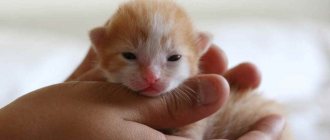How does a kitten's weight change as it gets older?
If babies are healthy, they will gain weight daily. A day after birth (second weighing), the weight of newborns, if they are not sick, will increase by at least 8-10 g. The strongest kittens gain 14 g in weight by the second day of life. If a baby whose weight at birth corresponded to the norm, during the second day of life he did not gain at least 7 g, this should alert the breeder.
A newborn baby should weigh up to 170 g
During the first week of life, a newborn's weight may double.
Important! The kitten, who lived for 10 days and gained 168-174 g, has passed the first critical milestone. The majority of newborns die during this period. Almost always the cause of death is a lack of mother's milk.
Kittens are fed around the clock at intervals of two hours. When eating, the kitten should lie on its stomach. It is unacceptable to feed your baby adult food, such as cow's or goat's milk. This can cause diarrhea and, as a result, weight loss and death. The breeder must also weigh the kittens daily and record the results.
How much should a cat weigh at different stages?
Chihuahua weight by month and week: table
During the first 15–20 days of life, kittens spend most of their time sleeping. After about 16 days from the moment of birth, babies begin to be interested in the events happening around them, frolic and play.
The table shows the weight of a growing kitten by month:
| Kitten age | Kitten weight by month | Note |
| 1st day of life | Approximately 99 g | Average weight of a newborn kitten |
| 7th day of life | 149 g | If a 7-day-old kitten weighs less than 99 g, he is either seriously ill or malnourished. |
| 14th day of life (0.5 months) | 170 g | The weight of a kitten is given, which is not sick with serious illnesses, but also does not receive the maximum portion of attention. |
| 21 days of life (0.7 months) | 225 g | With special care, kittens reach the specified weight at the age of 14 days |
| 35th day of life (1.2 months) | 450 g | The weight of an absolutely healthy, naturally strong kitten is indicated. |
| 2 months from the date of birth | 900 g | The cat no longer feeds her kittens; their future fate depends entirely on the owner. The permissible minimum weight at this age is 710 g |
| 3 months | 1400 g | The average weight of a typical kitten is indicated. |
| 4 months | 1800 g | Average weight |
| 5 months | 2300 - 2900 g | Male kittens weigh more than their sisters |
The table shows the average weight. The exact indicators depend on the breed, gender and health status of the kitten.
Outbred kittens develop in approximately the same way as purebred kittens, only their mortality rate is higher due to the lack of additional nutrition.
A weak kitten weighs very little from the first days of life
Note! An animal that at the time of birth weighed less than its littermates will not be able to do without additional nutrition. Pushed away from his mother's nipples by stronger brothers and sisters, he does not receive enough nutrition, does not gain weight and becomes weaker.
Kittens stop needing mother's milk within a month after birth. By this time, their fangs and incisors have erupted, their ears take a vertical position (in representatives of straight-eared breeds), and their weight reaches 440-470 g. A kitten that has reached six months of age is considered an adult and weighs about 3 kg.
Features of behavior
As a kitten grows up, not only the appearance, but also the behavior of the animal changes. It gradually becomes more active and playful, begins to show curiosity and independence. To determine the age of your pet, you should pay attention to the following nuances:
- Relationship with mother cat. Until the age of 1-1.5 months, kittens are completely dependent on their nursing mother and try not to leave her side. Starting from 6-7 weeks, they are gradually weaned off milk - you can even see the cubs asking to feed them, but the cat gets up and leaves. Two-month-old kittens are already calmly moving away from their mother and showing more interest in the surrounding space.
- Way to travel. Newborn animals can only crawl on their stomachs. They stand on their paws and learn to walk at about 2-3 weeks. At first, they move awkwardly and uncertainly, staggering and stumbling. At 3-4 weeks, babies acquire the famous cat-like ability to land on their paws when falling, turning their body in the air. A one-month-old kitten can stand on its feet and walk quite confidently, and after another week it begins to run.
- Reaction to stimuli. Newborn kittens do not show any reaction to rustling and moving objects. Starting from the age of 2-3 weeks, the cubs begin to notice stimuli, but do not show much interest in them. At the age of 5-6 weeks, babies begin to actively play and show interest in everything around them.
- Character traits. Little kittens are very timid, almost never leave their mother cat's side and try to run away and hide from everything and everyone. Only by 5-6 weeks do they begin to feel more confident and courageous - this is due to the fact that they are developing physically, growing, developing mobility and coordination. By about 7-8 weeks, babies become very curious and playful. They begin to run and jump a lot, explore the surrounding area, trying to get into every corner, and also try to actively communicate with people and other animals.
- Signs of puberty. The first of them can appear very early - at only 4 months. Kittens of this age begin to meow loudly, scratch the door and try to get out of the house. Males may begin to mark territory or even try to mate with cats. In females, signs of maturity appear a little later - at 4.5-6 months. They, like males, begin to mark their territory and scream loudly, as well as somersault on the floor and diligently lick themselves. Starting from the age of six months, cats also become more aggressive and begin to fight for territory. It is believed that these animals reach sexual maturity at 7 months.
The behavior of kittens largely depends on their living conditions, therefore this criterion for determining age cannot be called the most reliable. However, when combined with other methods, it provides more accurate information.
In most cases, determining the age of a cat is not difficult - for this there are several proven and fairly reliable methods available not only to a veterinarian, but also to the average person. Knowing the approximate date of birth of your pet, you can properly care for it.
Rules for weighing kittens
German Shepherd weight by month: table
Kittens must be weighed every day. If they look healthy, once is enough. Sick newborns, as well as those whose weight at birth was less than 80 g, are weighed twice a day. The weakest and most disease-prone babies are usually born in large litters (5 or more kittens).
Important! Experts recommend weighing them at the same time to get the best idea of newborns' rate of weight gain. Without this, the breeder will not be able to determine the amount of additional nutrition. Overfeeding kittens is no less difficult than underfeeding.
During the weighing session, the mother cat must be kept near the kittens so that she can see what is happening with her children. Excessive worry can negatively affect the quality of mother's milk. To create the most accurate picture of kittens growing up, experts advise:
- Mark identical kittens with different colored food dyes. This will make it easier to identify them. The tags will have to be periodically updated, since the cat, licking the babies, will wash them off;
- use electronic kitchen scales as the most accurate;
- record weighing results.
What does weight depend on?
Yorkie weight by month: table, standard, how many months it takes to grow
Male kittens weigh more than females as they grow up. With each new weighing, the difference increases. The weight of mature males and females is influenced by a number of factors.
Bengal cats
During the first week of life, the weight of a Bengal kitten can reach 250 g, and after another three weeks the baby will weigh from 400 to 500 g. A three-month-old teenager weighs about a kilogram.
A Bengal kitten reaches 1 kg at 3 months
Bengals are a fairly heavy breed, but they are never fat. Kittens are very active and energetic, they run a lot, they are always in excellent physical shape, although they look well-fed and even overfed. They owe their appearance to their natural muscularity.
Note! The weight of a Bengal kitten depends to the greatest extent on the development of its muscular system. We must not forget that Bengals are big-boned animals.
"British"
On the 7-8th day of life, 70-gram babies already weigh 110-150 g. When they are two weeks old, their weight will increase to 210-420 g. The specific weight depends on gender, health status and the number of kittens in the litter.
Scottish Fold
If at birth cats of this breed weigh 70-120 g, then after two weeks these figures increase to 440 g. A two-month-old “Scottish” kitten weighs about 800 g. After another month and a half, its weight will increase to 1.5 kg.
Representatives of this breed, even when they grow up, do not cease to look like teddy bears with a rounded head on a short neck and large, widely spaced round eyes. Males that have reached puberty weigh from 4 to 6 kg, and females - from 2.7 to 4 kg.
“Scots” are usually good-natured and calm. They love to be outdoors and never miss an opportunity to participate in outdoor games. Loneliness and a sedentary lifestyle make them depressed and, as a result, lead to obesity.
Siberian cats
Siberian cat kittens are born weighing 60-130 g. Girls and the weakest newborns weigh less, boys, as well as kittens born at the beginning of the litter, have the greatest weight. During the first month of life, their weight increases by 12-15 g daily.
Sphinxes
Representatives of this species require high-calorie food to avoid hypothermia. The weight of females that have reached the age of 8-9 months can reach 3-4 kg. Males weigh from 4 to 5 kg.
The Sphynx needs to be fed a special diet
Sphynx kittens are not separated from their mother until they are one month old. During this period they feed on her milk.
Thai cats
The weight of a 3-month-old male can reach 1.8 kg. A female at this age weighs about one and a half kilograms. When the kittens are six months old, the male will weigh approximately 2.9 kg and the female 2.3 kg.
Dangerous symptoms
Poor nutrition, lack of activity and weight control lead to overeating or undereating in cats. An outbred individual is able to independently control the amount of food eaten. Pedigree cats and animals in adulthood are characterized by a weak instinct towards food. Excessive eating leads to obesity.
The following symptoms help to recognize the disease: fat deposits, fatigue, apathy, lack of interest in games and shortness of breath. A malnourished cat is characterized by poor weight gain, bone visualization, and frequent illness. The presence of one or more symptoms requires immediate consultation with a veterinarian.
How to prevent obesity in kittens
The change in nutrition plan is carried out gradually. Experts advise extending the transition to a diet for 7-14 days. If the kitten does not receive its usual food for 3 days, and the new food is not to its taste, the period of forced fasting may affect the functioning of the liver. The best way to transfer an animal to a new food system is to gradually, in small portions, replace the usual food with dietary food.
Important! To prevent the kitten from overeating, portions must be dosed, and feeding should be done strictly according to the clock. If food is constantly at the animal’s disposal, it will be difficult for the owner to keep track of exactly how much the baby eats and at what time.
After filling the bowl with food, leave it for about 20 minutes and then remove it until the next meal. If the cat has already reached adulthood, it is recommended to give food 3-4 times a day during the first week, and 2-3 times a day during the second week. Ultimately, the daily dose is divided into 2 doses.
Portion sizes depend on the type of food and calorie content. The animal should receive the recommended daily dose corresponding to its weight (indicated on the package).
Common Digestive Problems
Feeding at 4 months is a challenging task for kitten breeders. If food is not given in porridge form, the animal may become constipated. And when prohibited foods are included in the diet, diarrhea occurs. In such a situation, the question arises: what is the treatment for diarrhea in a 4-month-old kitten? In what cases can you cope on your own, and when is it better to go to a veterinary clinic?
You should contact your veterinarian immediately if:
- Vomiting and diarrhea are present at the same time;
- There is diarrhea with blood;
- The disorder recurs more than 4 times a day.
Self-treatment involves a daily starvation diet. You can give the kitten a rehydron solution or salted water. A decoction of rice or a mixture of oak bark helps stop diarrhea when it is caused by poor diet. A decoction of flax seeds or oatmeal also perfectly helps eliminate the symptoms of the disease.
Children's smecta and activated charcoal should be given in case of illness. Bifidobacteria or lactobacilli can be given with a small amount of food on the second day of treatment.
When treating at home, you do not need to prescribe antibiotics to your cat yourself. At 4 months they will destroy all the microflora of his intestines. When diarrhea is severe, it is worth finding out the cause of the disease and eliminating it.
How much should a grown-up cat and cat weigh?
Bengal kittens stop growing when they reach 2 years of age. By this time, the weight of the female can reach from 3600 to 4500 g. The male will weigh 4500-6800 g. In some cases, the weight of an adult male Bengal can reach 10 kg or, conversely, not reach the norm (the minimum weight of a male is 3600 g), but This is rather an exception to the rule, rather than the norm. The same can be said about females. Female cats sometimes weigh much more than males.
Many breeders of Bengal cats believe that the weight of their pets exceeds the norm or, conversely, is below the acceptable minimum. The fact is that cats of this breed remain children longer than their relatives. They usually reach full physical development at the age of 3 years or so.
“The British” do not control their food intake, which is why they later suffer from obesity
Important! A peculiarity of British cats is their tendency to obesity. If the breeder does not regulate the pets' diet, they quickly gain excess weight.
Table for calculating the weight of a mature British cat by age.
| Gender | Permissible minimum weight | Permissible maximum weight | Expert opinion |
| 2 year old male | 4.1 kg with a height of 40 cm | 7.7 kg with a height of 50 cm | 6 kg regardless of height |
| 2 year old female | 3.2 kg with a height of 35 cm | 5.4 kg with a height of 45 cm | 5 kg regardless of height |
If the British dog's weight falls far short of the acceptable minimum, the breeder should think about additional nutrition. A veterinarian will help you decide on the amount and composition of feeding. The procedure for treating obesity in cats is not much different from the treatment for people suffering from excess weight. The best cure in both cases is diet and physical activity. If an obese kitten whose body is constantly growing, he most likely leads a sedentary lifestyle and receives an excessive amount of food. It is enough for the breeder to change the lifestyle of the ward.
For mature Siberians, a weight of 4 to 10 kg is considered normal. Both males and females are distinguished by their large dimensions and powerful muscular bodies. Female Siberian cats weigh between 4 and 6 kg. Males, if not sick, reach 6-10 kg.
For your information! To find out how much a Siberian cat weighs, you will need a bathroom scale. Experts suggest the following method: the breeder first weighs himself, and then, picking up the cat, weighs himself again. All that remains is to calculate the difference.
Thai male cats, upon reaching maturity, weigh from 5 to 6.8 kg. The weight of mature females ranges from 3.6 to 5.4 kg. Cats of this breed are natural gourmets; they never miss an opportunity to eat deliciously, so breeders have to constantly monitor their weight.
Getting used to a new place and training to a tray
At first, the kitten will miss its previous home, meows at night, pick it up and stroke it, talk to it. Caring for British kittens at 2 months is exactly like this. At night, you can put him on a warm heating pad, wrapping it in a towel (this will remind him of his mother or the presence of other kittens nearby). Take your time, let the Brit get comfortable.
shutterstock
If the animal was purchased from a nursery, they are often already litter box trained. If not, then it won't be difficult. After feeding, take your Brit to the toilet. It is better to fill the tray with wood filler. He will like it there and will quickly remember where to go. The tray should always be clean, this is the key to avoiding embarrassment. If there is an embarrassment, then it is worth punishing the kitten.
You shouldn't hit the kitten; a loud sound or clap is enough to make it scared; you can spray it with water.
This will develop a conditioned reflex and after the third time the kitten will understand that this is not worth doing. Never allow a cat's unacceptable behavior to go unpunished.
Number of kittens in the litter and their weight
The very first pregnancy ends for a cat with the birth of 2-3 kittens. Their weight in most cases is maximum - about 170 g. However, it is possible that weak and extremely light kittens will be born in the first litter. The minimum weight of a viable baby is:
- 60 g for a Siberian cat cub;
- 70 g for a Scottish Fold kitten and for representatives of most breeds.
For your information! After the second and subsequent pregnancy, the cat will become the mother of at least 8 kittens. Some females are capable of acquiring 8 or even 10 kittens when giving birth for the first time, but such cases are quite rare.
A purebred cat can give birth to up to 15 kittens.
A pregnant cat can give birth to 1 to 6 kittens
This number is due to the need to continue the race, despite the hostility of the environment, where mortality is much higher than among purebred cats living in comfortable conditions.
Diseases in cats that lead to obesity
The cause of extra pounds may not only be overeating.
Obesity is the scourge of many cats
The following diseases are often triggers of obesity:
- hypothyroidism (hormonal disease of the thyroid gland);
- insulinoma (pancreatic tumor);
- hypothalamic disorders;
- problems with the pituitary gland, the organ responsible for the production of hormones that affect metabolism.
Thus, everyone who wants to raise a healthy pet is obliged to control the weight of the animal. It is also important to dose the cat’s food so that he does not suffer from obesity later.











